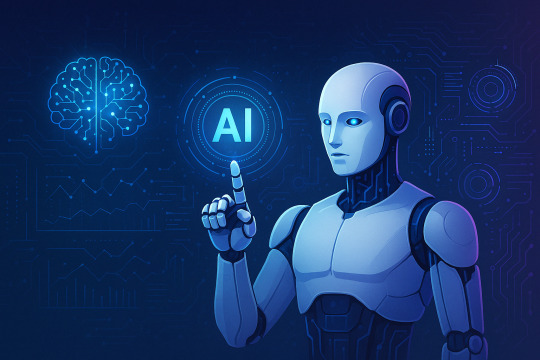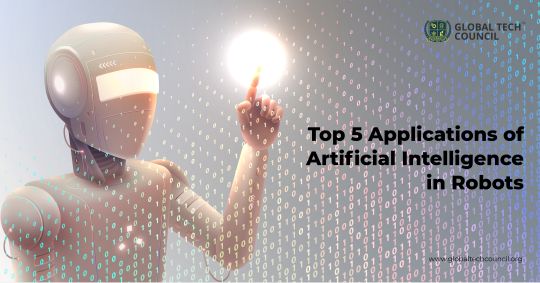#RoboticsAI
Explore tagged Tumblr posts
Photo

AI Revolution: The Future is Now. #ArtificialIntelligence #AIInnovation #FutureTech #RoboticsAI #MachineLearning #DigitalBrain #ad
0 notes
Text
Role of AI in Transforming Supply Chain Operations for Greater Efficiency
The modern supply chain is an intricate web of interconnected activities, requiring seamless coordination and precise execution. In this dynamic environment, Artificial Intelligence (AI) has emerged as a transformative force, reshaping the supply chain landscape and driving unprecedented levels of efficiency. By integrating AI into supply chain operations, businesses can optimize processes, enhance decision-making, and gain a competitive edge logistic institute in kochi
Understanding the Role of AI in Supply Chain Operations
AI involves the use of algorithms, machine learning (ML), and advanced analytics to process large volumes of data and generate actionable insights. In supply chain management, AI enhances operational efficiency by automating routine tasks, predicting outcomes, and enabling real-time decision-making.
From demand forecasting to inventory management, AI has become an indispensable tool in addressing the complexities of modern supply chains. The technology offers solutions to challenges such as fluctuating demand, supply disruptions, and inefficiencies in logistics and warehousing.
Key Applications of AI in Supply Chain Management
Demand Forecasting and Inventory OptimizationAI-powered tools analyze historical sales data, market trends, and external factors like weather or economic shifts to predict customer demand accurately. This enables companies to maintain optimal inventory levels, reducing overstocking and stockouts.
For example, retailers can use AI to forecast seasonal demand surges and adjust their procurement strategies accordingly. This level of precision minimizes waste and enhances profitability.
Predictive Maintenance in LogisticsAI-driven predictive maintenance monitors the health of transportation assets such as trucks, ships, and planes. By analyzing sensor data, AI can predict when a vehicle or equipment is likely to fail, allowing businesses to perform maintenance proactively.
This approach reduces downtime, prevents costly breakdowns, and ensures smooth logistics operations. Companies like DHL and FedEx are leveraging predictive maintenance to improve fleet reliability and efficiency.
Warehouse Automation and RoboticsAI-powered robots and automated systems are revolutionizing warehouse operations. These technologies facilitate faster picking, packing, and sorting of goods, significantly reducing labor costs and error rates.
AI also enables warehouse management systems to analyze space utilization and optimize layout designs for improved efficiency. Amazon's fulfillment centers, for instance, use AI-driven robotics to enhance order processing speed.
Route Optimization in TransportationAI algorithms analyze traffic patterns, weather conditions, and delivery schedules to determine the most efficient routes for transportation. This reduces fuel consumption, cuts transit times, and improves customer satisfaction.
Companies like UPS and Uber Freight use AI-powered route optimization tools to streamline delivery operations, ensuring timely shipments.
Risk Management and Supply Chain ResilienceGlobal supply chains are vulnerable to disruptions caused by natural disasters, geopolitical events, or economic uncertainties. AI helps businesses identify potential risks by analyzing diverse data sources in real time.
With this insight, companies can develop contingency plans, diversify suppliers, and mitigate risks effectively. AI-driven risk management strengthens supply chain resilience and ensures business continuity.
Enhanced Customer ExperienceAI improves customer satisfaction by enabling faster and more accurate order processing. Chatbots powered by AI handle customer inquiries efficiently, providing real-time updates on order status and delivery schedules.
Additionally, AI-driven systems ensure personalized recommendations and inventory availability, enhancing the overall shopping experience.
Benefits of AI in Supply Chain Management
Increased EfficiencyAI automates repetitive tasks, streamlines workflows, and optimizes resource allocation, leading to significant time and cost savings.
Data-Driven Decision-MakingWith AI, businesses can analyze vast amounts of data and derive actionable insights, enabling informed and timely decisions.
Scalability and FlexibilityAI solutions adapt to the evolving needs of businesses, allowing them to scale operations without compromising efficiency.
SustainabilityBy reducing waste, optimizing routes, and improving inventory management, AI contributes to sustainable supply chain practices.
Enhanced VisibilityAI-powered tools provide end-to-end visibility into supply chain activities, fostering transparency and collaboration across stakeholders.
Challenges in Implementing AI in Supply Chains
While the benefits of AI are evident, its adoption comes with challenges.
High Implementation CostsDeploying AI systems requires significant investment in technology, infrastructure, and skilled personnel.
Data Quality and IntegrationAI's effectiveness depends on access to accurate and comprehensive data. Fragmented systems and poor data quality can hinder its performance.
Change ManagementIntroducing AI involves transforming traditional workflows, which may face resistance from employees accustomed to legacy systems.
Ethical ConcernsThe use of AI in decision-making raises ethical questions about data privacy, bias, and accountability. Businesses must address these concerns proactively.
The Future of AI in Supply Chains
As AI technology continues to evolve, its role in supply chain management will expand further. Key trends to watch include:
Integration with IoTThe combination of AI and the Internet of Things (IoT) will enable real-time monitoring and control of supply chain operations, enhancing responsiveness.
Advanced Analytics and Edge ComputingAI-powered analytics will become more sophisticated, while edge computing will allow data processing closer to the source, reducing latency.
Collaborative AI SystemsAI will facilitate greater collaboration between stakeholders, enabling dynamic adjustments to supply chain strategies.
Focus on SustainabilityAI will play a crucial role in achieving sustainability goals by optimizing resource utilization and reducing carbon footprints.
The role of AI in transforming supply chain operations is undeniable. By automating processes, improving decision-making, and enhancing efficiency, AI empowers businesses to navigate the complexities of modern supply chains.
Despite the challenges, the adoption of AI offers a pathway to achieving greater resilience, sustainability, and customer satisfaction. As companies embrace this transformative technology, they position themselves for long-term success in an increasingly competitive market logistics courses in kochi
0 notes
Text
Don’t sweat the singularity
http://dlvr.it/SXcm1f
0 notes
Text
Top 5 Applications of Artificial Intelligence Robotics

Robotics artificial intelligence is a subfield of artificial intelligence that focuses on the development of intelligent machines or robots. As a backend, they have mechanical structures, electronic systems, and programming languages. Furthermore, robotics is a combination of electrical engineering, mechanical engineering, and computer science and engineering.
Despite the fact that robotics and artificial intelligence experts perform distinct functions, many people regard robotics as a subset of AI developers. Robot machines that have received artificial intelligence certification have a human-like appearance and can perform in the same way that humans do. Although the use of robotic applications has declined, by combining them with artificial intelligence, they have become smarter and more efficient.
What is the purpose of artificial intelligence?
Artificial intelligence is a growing field of computer science concerned with creating intelligent computers that behave similarly to humans. Thanks to artificial intelligence experts, robots can detect, act, comprehend, and learn in the same way that humans do. Reactive machines, limited memory, theory of mind, and self-awareness are the four primary artificial intelligence certification categories.
Artificial intelligence applications in robotics
AI has a wide range of applications in robotics. Some of the most important robotics applications are as follows:
Artificial Intelligence Robotics in the Defense Industry
Without a doubt, one of a country's most important aspects is its defence industry. Every country wishes to have a strong defence system. During a conflict, robots aid in the approach to inaccessible and dangerous areas.
The combination of artificial intelligence in robotics and human-like vision in robotics enables robotics to identify and distinguish a wide range of objects. The defence R&D organisation has developed a robot capable of safely removing potentially lethal objects.
In the Entertainment Industry, Robotics and Artificial Intelligence
The use of AI in robotics applications in the entertainment industry has steadily increased over the last decade. In robotics, artificial intelligence assists models in learning to perform specific tasks and makes robots more intelligent to operate in a variety of environments.
Robotics has applications in the entertainment industry, such as movies, games, animation, and cartoons. Robots are extremely useful in situations that require a great deal of repetition. A camera-wielding robot assists in filming a scene as many times as needed without becoming tired or irritated.
In the Mining Industry, Artificial Intelligence Robots
AI in robotics is being actively used in a variety of mining projects due to its broad range of applications. Automatic dozing, robotic surveying and mapping, robotic drilling, and explosive handling are all examples of this. With the assistance of other sensors, a mining robot can navigate flood corridors.
Robotics-specific artificial intelligence has been specifically trained to perform specific tasks with greater precision and efficiency. Additionally, robots aid in excavation by detecting gases and other contaminants, as well as protecting humans from harm and injury.
Artificial Intelligence Robotics in the Medical Field
Robotics with artificial intelligence can help with inventory automation and proper transportation from one location to another, reducing the need for human labour in such repetitive activities. Laparoscopy, orthopaedic surgery, neurosurgery, medicine administration, room cleaning, and other medical disciplines benefit from the use of robots.
Robotics powered by artificial intelligence are being used in the industrial sector
AI can assist robots in picking up and placing boxes in the proper locations, as well as unloading them from vehicles more quickly and accurately. AI robots can help with cutting, welding, disassembly, assembly, pick and place print circuit boards, labelling and packing, and quality inspection.
Additionally, robotics technology increases productivity and profits while decreasing human labour, resulting in less physical strain and damage. The industrial robot also has a number of significant advantages, which are as follows:
Realism
Stretch
The labour cost is lower
Low-noise operation
Productivity has risen
Losses in production are reduced
What exactly are artificial intelligence robots?
AI-enabled robots combine artificial intelligence and robotics. AI in robotics is managed by AI programmes that use a variety of AI developer technologies such as machine learning, computer vision, and reinforcement learning. The vast majority of robots are not used for AI training. They are intended for repetitive tasks and do not require artificial intelligence certification. Unfortunately, the utility of these robots is limited.
Furthermore, AI algorithms will be required if the robot is to perform increasingly complex tasks. A path-finding algorithm could be used by a warehousing robot to navigate the warehouse. When a drone's battery runs out, it may use autonomous navigation to find its way home. A self-driving car may also use a variety of AI systems. These are all examples of robots that have been taught artificial intelligence.
Conclusion
One of the most significant benefits of artificial intelligence in robotics is social care. Individuals, particularly those who assist the elderly, can be led by chatbot-like social skills and powerful processors. The agricultural industry can benefit from the advancement of artificial intelligence in robotics.
Furthermore, artificial intelligence in robotics is useful in volcanoes, extremely cold environments, deep oceans, and event spaces where people could die. AI in Robotics is useful in the medical and healthcare industries because it can perform difficult procedures that are prone to human error.
#artificial intelligence expert#ai developer#artificial intelligence certification#ai certification#artificial intelligence training
0 notes
Text
Stanford’s Doggo quadrupedal robot and siblings Pupper and Woofer are coming to TC Sessions: Robotics+AI
Animal-like, four-legged robots have been a crowd pleaser since Boston Dynamics’ BigDog, and Stanford’s Doggo shows how the technology can be made open source, accessible, and educational. Doggo’s creators will bring the diminutive robot, plus its smaller and larger siblings Pupper and Woofer, to TC Sessions: Robotics+AI on March 3.
P.S. Early bird ticket sales end this Friday – book your tickets today and save $150.
We first heard of Doggo last year when the Stanford Robotics Club showed off the highly capable design, which uses mostly off-the-shelf parts and can be assembled by anyone… as long as ��anyone” has considerable experience building robots and a couple thousand dollars to spend.
Still, a couple thousand is an order of magnitude or two lower than most quadrupedal robots go for, and project lead Nathan Kau told TechCrunch they’ve seen a ton of interest.
“I had no idea how many people were going to pick it up,” he said. “It’s complicated! But I get emails every day from people building this thing, from all over. The first team to get it running, to my knowledge, was in Sri Lanka.”
In order to further push the lower bounds of who can build and experiment with a robot like this, the team is building a smaller, even less expensive robot called Pupper. They hope to get the cost down to the level where even high school clubs can afford one.
“It’s less than $500 in development materials if you make it by yourself,” said Kau. “We imagine that if it becomes a kit and we have a partnership with the part manufacturers, it could be much less. We built it as a platform for learning, so it uses a Raspberry Pi and everything is programmed in Python. It’s about as complicated as building a drone, I’d say.”
You’ll be able to see Doggo and Pupper in action at the event, and they’ll be joined by one more robot: Woofer, a jumbo-sized step up from the others. It’s earlier in development than the other two, but to keep things simple it shares much of its codebase with the others.
Grab your tickets to the show today and get to see these awesome robots in person and hear from today’s leading minds in the industry. Early bird tickets expire this Friday, Jan. 31, so book yours today and save $150 before prices go up.
( function() { var func = function() { var iframe = document.getElementById('wpcom-iframe-a4fad19c68e846fecc75f11477e3b068') if ( iframe ) { iframe.onload = function() { iframe.contentWindow.postMessage( { 'msg_type': 'poll_size', 'frame_id': 'wpcom-iframe-a4fad19c68e846fecc75f11477e3b068' }, "https:\/\/tcprotectedembed.com" ); } } // Autosize iframe var funcSizeResponse = function( e ) { var origin = document.createElement( 'a' ); origin.href = e.origin; // Verify message origin if ( 'tcprotectedembed.com' !== origin.host ) return; // Verify message is in a format we expect if ( 'object' !== typeof e.data || undefined === e.data.msg_type ) return; switch ( e.data.msg_type ) { case 'poll_size:response': var iframe = document.getElementById( e.data._request.frame_id ); if ( iframe && '' === iframe.width ) iframe.width = '100%'; if ( iframe && '' === iframe.height ) iframe.height = parseInt( e.data.height ); return; default: return; } } if ( 'function' === typeof window.addEventListener ) { window.addEventListener( 'message', funcSizeResponse, false ); } else if ( 'function' === typeof window.attachEvent ) { window.attachEvent( 'onmessage', funcSizeResponse ); } } if (document.readyState === 'complete') { func.apply(); /* compat for infinite scroll */ } else if ( document.addEventListener ) { document.addEventListener( 'DOMContentLoaded', func, false ); } else if ( document.attachEvent ) { document.attachEvent( 'onreadystatechange', func ); } } )();
from RSSMix.com Mix ID 8176395 https://techcrunch.com/2020/01/29/stanfords-doggo-quadrupedal-robot-and-siblings-pupper-and-woofer-are-coming-to-tc-sessions-roboticsai/ via http://www.kindlecompared.com/kindle-comparison/
0 notes
Photo

New Post has been published on https://magzoso.com/tech/stanfords-doggo-quadrupedal-robot-and-siblings-pupper-and-woofer-are-coming-to-tc-sessions-roboticsai/
Stanford’s Doggo quadrupedal robot and siblings Pupper and Woofer are coming to TC Sessions: Robotics+AI


Animal-like, four-legged robots have been a crowd pleaser since Boston Dynamics’ BigDog, and Stanford’s Doggo shows how the technology can be made open source, accessible, and educational. Doggo’s creators will bring the diminutive robot, plus its smaller and larger siblings Pupper and Woofer, to TC Sessions: Robotics+AI on March 3.
P.S. Early bird ticket sales end this Friday – book your tickets today and save $150.
We first heard of Doggo last year when the Stanford Robotics Club showed off the highly capable design, which uses mostly off-the-shelf parts and can be assembled by anyone… as long as “anyone” has considerable experience building robots and a couple thousand dollars to spend.
Still, a couple thousand is an order of magnitude or two lower than most quadrupedal robots go for, and project lead Nathan Kau told TechCrunch they’ve seen a ton of interest.
“I had no idea how many people were going to pick it up,” he said. “It’s complicated! But I get emails every day from people building this thing, from all over. The first team to get it running, to my knowledge, was in Sri Lanka.”
In order to further push the lower bounds of who can build and experiment with a robot like this, the team is building a smaller, even less expensive robot called Pupper. They hope to get the cost down to the level where even high school clubs can afford one.
“It’s less than $500 in development materials if you make it by yourself,” said Kau. “We imagine that if it becomes a kit and we have a partnership with the part manufacturers, it could be much less. We built it as a platform for learning, so it uses a Raspberry Pi and everything is programmed in Python. It’s about as complicated as building a drone, I’d say.”
You’ll be able to see Doggo and Pupper in action at the event, and they’ll be joined by one more robot: Woofer, a jumbo-sized step up from the others. It’s earlier in development than the other two, but to keep things simple it shares much of its codebase with the others.
Grab your tickets to the show today and get to see these awesome robots in person and hear from today’s leading minds in the industry. Early bird tickets expire this Friday, Jan. 31, so book yours today and save $150 before prices go up.
0 notes
Text
Waymo Anca Dragan and"IKE"robotics Jur van den Berg to the TC meeting: robotics+AI.
News has been published on http://havensos.com/news/waymo-anca-dragan-andikerobotics-jur-van-den-berg-to-the-tc-meeting-roboticsai-2020
Waymo Anca Dragan and"IKE"robotics Jur van den Berg to the TC meeting: robotics+AI.

The road to”solve”self-driving car is fraught with challenges, from perception and decision-making to understand the interaction between human and robot. Today, we announced, join our …
0 notes
Link
via TechCrunch 3G wifi Sahaha https://3gwifi.net/ 368 đường láng, Đống Đa, hà nội 19002106 [email protected] https://3gwifi.net/danh-muc/bo-phat-wifi-4g/ https://3gwifi.net/danh-muc/usb-4g-dcom-4g/ https://3gwifi.net/danh-muc/sim-3g/ https://3gwifi.net/danh-muc/wifi-du-lich/ https://3gwifi.net/danh-muc/may-phien-dich/ https://goo.gl/maps/W9Wk6vrue6aW8yuP7 3gwifisahaha Sahaha cung cấp usb 4G✅ Dcom 4G✅ Sim 4G✅Bộ phát wifi 4G chính hãng✅ Uy tín Giá rẻ nhất✅ 19002106
0 notes
Text
Supply chain firm NFI inks $10M deal to deploy Boston Dynamics’ Stretch robots
http://dlvr.it/SXXvxh
0 notes
Link
AI expert Stuart Russell to join TC’s Robotics+AI 2020 at UC Berkeley - TechCrunch https://ift.tt/2ro9pZK
0 notes
Photo

New Post has been published on https://magzoso.com/tech/unearth-the-future-of-agriculture-at-tc-sessions-roboticsai-with-the-ceos-of-traptic-farmwise-and-pyka/
Unearth the future of agriculture at TC Sessions: Robotics+AI with the CEOs of Traptic, Farmwise and Pyka


Farming is one of the oldest professions, but today those amber waves of grain (and soy) are a test bed for sophisticated robotic solutions to problems farmers have had for millennia. Learn about the cutting edge (sometimes literally) of agricultural robots at TC Sessions: Robotics+AI on March 3 with the founders of Traptic, Pyka, and Farmwise.
Traptic, and its co-founder and CEO Lewis Anderson, you may remember from Disrupt SF 2019, where it was a finalist in the Startup Battlefield. The company has developed a robotic berry picker that identifies ripe strawberries and plucks them off the plants with a gentle grip. It could be the beginning of a new automated era for the fruit industry, which is decades behind grains and other crops when it comes to machine-based harvesting.
Farmwise has a job that’s equally delicate yet involves rough treatment of the plants — weeding. Its towering machine trundles along rows of crops, using computer vision to locate and remove invasive plants, working 24/7, 365 days a year. CEO Sebastian Boyer will speak to the difficulty of this task and how he plans to evolve the machines to become “doctors” for crops, monitoring health and spontaneously removing pests like aphids.
Pyka’s robot is considerably less earthbound than those: an autonomous, all-electric crop-spraying aircraft — with wings! This is a much different challenge from the more stable farming and spraying drones like those of DroneSeed and SkyX, but the choice gives the craft more power and range, hugely important for today’s vast fields. Co-founder Michael Norcia can speak to that scale and his company’s methods of meeting it.
These three companies and founders are at the very frontier of what’s possible at the intersection of agriculture and technology, so expect a fruitful conversation.
$150 Early Bird savings end on Feb. 14! Book your $275 Early Bird Ticket today and put that extra money in your pocket.
Students, grab your super discounted $50 tickets right here. You might just meet your future employer/internship opportunity at this event.
Startups, we only have 5 demo tables left for the event. Book your $2200 demo table here and get in front of some of today’s leading names in the biz. Each table comes with 4 tickets to attend the show.
0 notes
Text
Digging into key takeaways from our 2019 Robotics + AI Sessions event
Extra Crunch offers members the opportunity to tune into conference calls led and moderated by the TechCrunch writers you read every day. This week, TechCrunch’s Brian Heater and Lucas Matney shared their key takeaways from our Robotics + AI Sessions event at UC Berkeley last week.
The event was filled with panels, demos and intimate discussions with key robotics and deep learning founders, executives and technologists. Brian and Lucas discuss which companies excited them most, as well as which verticals have the most exciting growth prospects in the robotics world.
“This is the second [robotics event] in a row that was done at Berkeley where people really know the events; they respect it, they trust it and we’re able to get really, I would say far and away the top names in robotics. It was honestly a room full of all-stars.
I think our Disrupt events are definitely skewed towards investors and entrepreneurs that may be fresh off getting some seed or Series A cash so they can drop some money on a big-ticket item. But here it’s cool because there are so many students. robotics founders and a lot of wide-eyed people wandering from the student union grabbing a pass and coming in. So it’s a cool different level of energy that I think we’re used to.
And I’ll say that this is the key way in which we’ve been able to recruit some of the really big people like why we keep getting Boston Dynamics back to the event, who generally are very secretive.”
Brian and Lucas dive deeper into how several of the major robotics companies and technologies have evolved over time, and also dig into the key patterns and best practices seen in successful robotics startups.
For access to the full transcription and the call audio, and for the opportunity to participate in future conference calls, become a member of Extra Crunch. Learn more and try it for free.
source https://techcrunch.com/2019/04/23/roboticsai-sessions-recap-conference-call/
0 notes